Serviços Personalizados
Journal
Artigo
Indicadores
-
 Citado por SciELO
Citado por SciELO -
 Acessos
Acessos
Links relacionados
-
 Similares em
SciELO
Similares em
SciELO
Compartilhar
Revista mexicana de ingeniería química
versão impressa ISSN 1665-2738
Rev. Mex. Ing. Quím vol.10 no.3 Ciudad de México Dez. 2011
Ingeniería en alimentos
Effect of extrusion cooking on the functional properties and starch components of lentil/banana blends: Response surface analysis
Efecto de la extrusión en las propiedades funcionales y componentes del almidón de mezclas lenteja–plátano: Análisis de superficie de respuesta
R.G. Hernández–Nava1, L.A. Bello–Pérez2, E. San Martín–Martínez3, H. Hernández–Sánchez1 and R. Mora–Escobedo 1*
1 Departamento de Graduados e Investigación en Alimentos, E.N.C.B., I.P.N. Prol. Carpio y Plan de Ayala, Col. Sto. Tomás, México, D.F. CP. 11340. Corresponding author. E–mail: rosalmora@hotmail.com Tel. 55–57296000 Ext. 62462
2 Centro de Desarrollo de Productos Bióticos del IPN, Apartado postal 24. C.P. 62731, Yautepec, Morelos, México.
3 CICATA, I.P.N. Legaria. Av. Legaria No. 694. Col. Irrigación, México, D.F. C.P. 11500.
Received 6 of July 2011.
Accepted 29 of July 2011.
Abstract
Banana and lentil flour blends were processed in a sing le screw extruder modifying the flour properties of the blend (20.5–79.5%), at selected range of die temperature (145–175 ºC) and the feeding moisture content (20–24%). Functional characteristics evaluated in the extrudates were water absorption index (WAI), water solubility index (WSI), bulk density (BD), paste viscosity properties, microstructure and resistant starch content. The concentration of lentil/banana blends and temperature were the most important variables affecting dependent variables WAI, WSI, BD and vrscosity properties. The results of this study indicated that extrusion cooking induced desirable functional characteristics to lentil/banana blends by increasing their resistant starch content.
Keywords: extrusion, lentil flour, banana flour, functional properties.
Resumen
Se procesaron harinas de lenteja y plátano en un extrusor de tornillo simple, modificando la proporción de harina (20.5–79.5%), la temperatura de dado (145–175 ºC) y la humedad de alimentación (20–24%). Las propiedades funcionales evaluadas en los extrudidos fueron índice de absorción de agua (IAA) y de solubilidad (ISA), densidad aparente (DA), perfil de viscosidad, cambios microestructurales y contenido de almidón resistente. La proporción de las harinas de lenteja/plátano fueron las variables independientes que más afectaron a las variables dependientes IAA, ISA, DA y viscosidad. Los resultados de este estudio muestran que la mezcla de lenteja/plátano, después de la cocción por extrusión provee características funcionales deseables, con un alto contenido de almidón resistente.
Palabras clave: extrusión, harina de lenteja, harina de plátano, propiedades funcionales.
1 Introduction
Extrusion cooking technology is a continuous, high–temperature, short–time process with high capability of production at low cost. Extrusion converts raw materials into shelf–stable finished food products with enhanced textural attributes and flavor. Extrusion has been used to develop various types of snack foods, mainly from corn meal, rice, wheat or potato flour, in many shapes and variety of textures. Extrusion cooking modifies the digestible characteristic and functional properties, such as paste viscosity, water absorption and water solubility indexes, expansion index and bulk density of protein and starch molecules (Ali et al., 1996; Hernandez–Diaz, et al., 2007).
Published studies have focused on the use of extrusion technology to process cereals, vegetables, fruits and legumes to improve their nutritional profile (Liu et al., 2000; Berrios, 2006). Lentil flour has potential for traditional and newer product developments with health benefits since it contains about 25% protein, 56% carbohydrate and 1% fat. Lentils are considered as one of the best and low–cost sources of vegetable proteins and are also a good source of B–complex vitamins, such as folate, thiamine, niacin and riboflavin (Fikry et al., 1980; Adsule et al., 1989). They have appropriate balance of minerals, a high amount of dietary fiber and complex carbohydrates involved in low glycemic index (Shams et al., 2008). Lentils have been associated with cholesterol and lipid lowering effects in humans, along with a reduction of the incidence of colon cancer and type–2 diabetes (Leterme, 2002; Shams et al., 2008). On the other hand, the consumption of banana is mainly in its ripe state. In Mexico, the postharvest handling of banana is relatively poor and, as a consequence, large quantities of this fruit are lost during commercialization. Unripe banana has been investigated and the studies indicated that these fruits had 17.5% of resistant starch (RS) and 14.5% of dietary fiber. Based on this finding, the consumption of unripe bananas could improve the colon health (Faisant et al., 1995; Juarez–Garcia et al., 2006). For this reason the flour obtained from this fruit could be considered a functional ingredient for the food industry.
The objective of this study was to investigate the effect of extrusion processing on the functional properties and starch components of blend of lentil and banana flours.
2 Methodologies
2.1 Raw materials
Commercial hard green (unripe) pre–climacteric bananas (Musa paradisiaca L.) were purchased from a local market in Cuautla, Morelos, Mexico. Fruits were peeled and cut into 5 mm slices and immediately rinsed in citric acid solution (0.3% w/v). The slices were dried at 50ºC in a convection oven. The lentils (Lens culinaris) were purchased from "Local Productores Unidos de Huaniqueo", (Huaniqueo, Michoacán, México). Lentils and dried banana slices were ground using a commercial grinder (Mapisa Internacional S.A. de C.V., D.F., México) to pass through a US 40 sieve and stored at 25ºC in sealed plastic containers until further analyses.
2.2 Chemical analysis
Moisture, ash, protein and fat analyses of raw materials were carried out according to the procedures of AOAC (1990). All the determinations were performed in triplicate.
2.3 Samples conditioning
Banana and lentil flours were mixed (Maren type 10, Effort, Copenhagen, Denmark) and spray–atomized with water, to reach the various moisture contents indicated in the central composite experimental design (Table (1) 2). The samples were stored in plastic bags at 4ºC for subsequent processing.
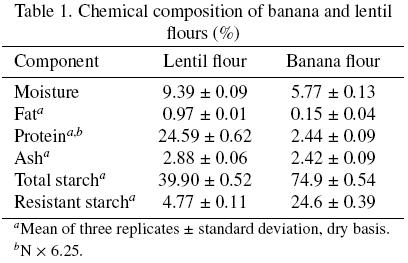
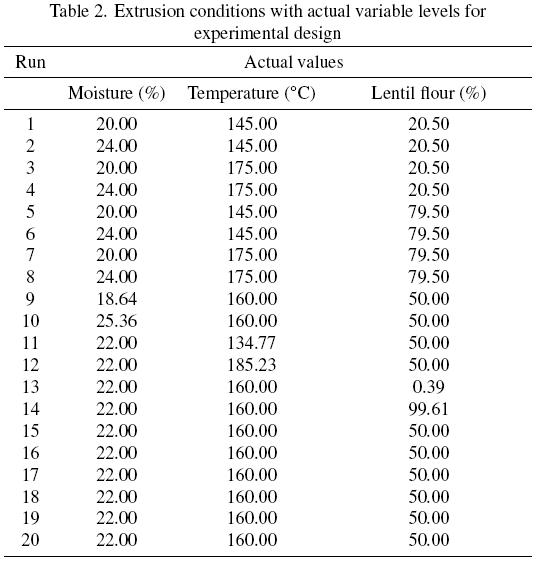
2.4 Extrusion
Materials were processed in a single–screw extruder (CICATA – IPN, México, D.F.), 60 mm diameter and 950 mm length screw. The barrels contained three controlled heating and cooling zones. The diameter of the hole in the die was 12.5 mm. Three thermocouples were used to monitor the barrel temperatures and one extra thermocouple was inserted in the die plate. The materials were fed to the extruder at 25 Hz, controlled with a Baldor Electric Co. Cat. GPP 7454 MDF (FT Smith, AR, USA). Extrusion was carried out at different temperatures, moisture contents and flour blend proportions, according to the experimental design shown in Table 2. The resulted extruded products were stored in polyethylene bags until further analysis.
2.5 Experimental design and statistical analysis
To analyze the influence of independent variables on functional characteristics of lentil and banana blends, response surface methodology (RSM) was used. A central–composite rotable design (Montgomery, 2004; Velazquez–Trujillo et al., 2010) was selected with three variables: ratio of lentil to banana flour (20.579.5%), feed moisture content (20–24%) and die temperature (145–175ºC). Six repetitions were made at the central point conditions. Treatments were performed randomly and results were analyzed using the statistical program Design expert ® version 8.0.4. (Minneapolis, MN, USA). The significance of the models was tested by variance analysis (test F) and the determination coefficient R2, and values and significance of the independent variables were also calculated, considering, α = 0.05.
2.6 Characterization of the extruded samples
The extruded samples were milled to pass through a 60 mesh sieve and stored at room temperature in plastic bags. In all analytical determinations, the average of three measurements was reported.
2.6.1 Water absorption index (WAI) and water solubility index (WSI)
The WAI and WSI of the extruded materials were determined using the procedure reported by Anderson (1982).
2.6.2. Bulk density (BD)
The BD was determined by the method proposed by Hsieh et al. (1990).
2.6.3. Viscosity profile: Maximum viscosity (MV) and Final Viscosity (FV)
The viscosity profile was determined according to the method used by Guerra–DellaValle et al. ( 009). Tests were carried out in a Rapid Visco Analyser (RVA–4D; Newport Scientific Pty, Warriewood, Australia). The sample preparation was done, using a total test sample of 8 g, taking into account the initial moisture of each extruded sample. The samples were placed in a canister and the suspension was heated from 50 to 90ºC in 5 min and held at 90ºC for another 5 min, then cooled down to 50ºC for an extra 6 min so that the total time of analysis was 16 min at 160 rpm. Relative viscosity was reported in centipoises (cPs) and the following parameters were obtained from the curve: MV (maximum viscosity obtained during the heating) and FV (final viscosity at the end of the test).
2.6.4. Total and resistant starch
Total starch (TS) was determined by the method of Goñi et al. (1997); 50 mg of sample were dispersed in 2 M KOH (30 min); then samples were incubated with amyloglucosidase (Boehringer, No. 102857, 60° C, 45 min, pH 4.75), and glucose was determined using the glucose oxidase assay GOD–POD. TS was calculated as released glucose (mg) × 0.9.
Resistant starch (RS) was evaluated by the method of Goni et al. (1996). Protein and digestible starch were removed with pepsin (P–7012, 2500– 3500 units/mg protein, Sigma Chemical Co., St. Louis, MO) by incubation at 40° C, pH 1.5 for1 h and with a–amylase (A–3176, 10–30 units/mg solid, Sigma Chemical Co.) incubating at 37 ºC, pH 6.9 for 16 h. The residue was treated with 2 M KOH and then incubated with amyloglucosidase (A–7255, 5000 units/g solid, Sigma Chemical Co.) at 60ºC and pH 4.75, for 45 min. Glucose was determined using glucose oxidase/peroxidase assay (SERA–PAK ® Plus, Bayer de Mexico, S.A. de C.V., Edo. de México). RS was calculated as mg glucose × 0.9.
2.6.5. X–ray diffraction
Samples, before the analysis were stored in a sealed container at a relative humidity of 82% for obtaining a constant moisture content; then, they were analyzed between 2θ = 10º and 2θ = 50º with a step size 2θ = 0.02º in an X–ray diffractometer (Philips PW 1710, The Netherlands) using Cu Kα radiation (λ = 1.543), 50 kV and 30 mA. The diffractometer was equipped with a 18 divergence slit and a 0.1 mm receiving slit (González–Soto et al., 2007). Starch crystallinity determination with X–ray difraction is generally carried out following different methods (Rindlav–Westling et al., 2002). These methods calculate crystallinity by subtracting the amorphous contribution from the measured spectra. A sample containing amorphous maize starch was prepared and its diffraction spectrum used as the amorphous contribution in the measured spectra. Crystallinity was calculated by subtracting the amorphous contribution in each spectrum according to Equation (1) (Rodríguez, 1995):

Where:
% C = Percent crystallinity
Ap = Area of crystalline peaks (from the difference between the area under the curve and of the amorphous halo).
At = Total area under the curve
N = Instrument noise
3 Results and discussion
3.1 Chemical composition of raw materials
The raw materials had very similar mineral composition, whereas moisture, fat and protein content were higher in lentil flour (Table 1). Lentil protein, lipids and ash content were similar to values reported by Cai et al. (2001). As expected, the highest resistant starch content was found in banana flour.
3.2 Water absorption index
The Water Absorption Index (WAI) measures the amount of water absorbed by starch and can be used as an index of gelatinization (Anderson et al., 1969). The gelatinization is the conversion of raw starch into a cooked and digestible material by the application of water and heat. Also, gelatinization is one of the important effects that extrusion has on the starch component of foods.
Table 3, shows the regression coefficients for a second–order model for WAI. The coefficients that had a significant effect (P < 0.05) on WAI, were the linear term M (flour moisture content) and T (die temperature), the quadratic effect of T and the interaction of M and T.
The response surface graph (Fig. 1) shows that the maximum WAI value was found at the highest moisture content. Similar effect of moisture content on WAI has been reported for rice and pea grit (Singh et al., 2007). At high moisture content, the viscosity of the starch would be low, allowing for extensive internal mixing and uniform heating which, in turn, would account for enhanced starch gelatinization (Lawton et al., 1972); it also may lead to increased water absorption. Lower WAI values were observed at lower moisture content and high lentil flour concentration in the blend. Lentils are reach source of protein. So, as the lentil flour increase in the blend, the protein content increased in the extrudates. The WAI depends on availability of hydrophilic groups which bind water molecules and on the gel forming capacity of macromolecules. Although legume proteins have hydrophilic groups, the protein denaturation during extrusion cooking leads to loss of hydration capacity of proteins. The lower hydration capacity is favored by the formation of inter– and intra–molecular protein bonds with amylose and amylopectin (Fernandez–Gutierrez et al., 2004).
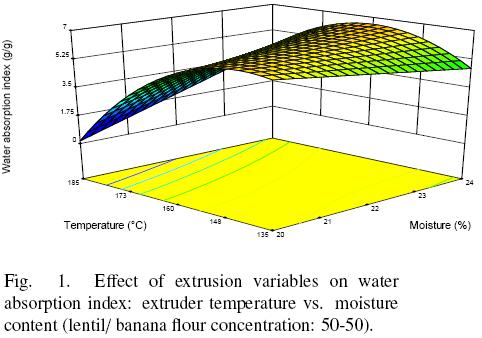
3.3 Water solubility index
The Water Solubility Index (WSI) is related to the quantity of water soluble molecules, and is associated to dextrinization. In other words, WSI can be used as an indicator of the degradation of molecular compounds, and measures the starch degradation resulted from extrusion cooking (Colonna, et al., 1989; Ding et al., 2005). Recently, WSI was used as an indicator for evaluating the degree of cooking in bean extrudates (Drago et al., 2007).
The model equation predicting the response is given in the Table 3, the determination coefficient for this model was R2 = 0.8472 and P = 0.0044. The terms that showed significant effect on WSI (P < 0.05) were: T , C, T 2 and MT . This surface response model is shown in Fig. 2. The lower WSI values were found at moisture 22%, temperature 150 C and 50% of banana flour and 50% lentil flour, whereas the maximum values of WSI were obtained in the extrudates processed at moisture 20%o, 180 C and highest concentrations of banana flour in the blends.
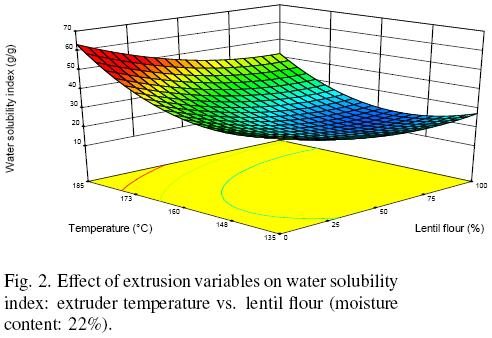
The blends with highest levels of lentil concentration (consequently higher protein content) processed at high or low moisture content and low temperature, presented low WSI values (Fig. 2).
This result indicated that protein present in the blends lost solubility by denaturation, when it was subjected to high extrusion temperature. Also due to loss of protein solubility by denaturation, structural changes may have occurred which allowed hydrophilic groups such as –OH, –NH2, –COOH, and –SH to form crosslinks with starch (Ramirez–Ortiz et al., 2008).
3.4 Bulk density
Bulk density is a very important parameter in the production of expanded and formed food products, as the bulk density considers expansion in all directions (Wang and Ballington, 2007). The regression equation for BD is presented in the Table 3. The extrusion variables that had a significant effect on the BD, were M, T and C, M2, T and MC. The BD of the extrudates was between 0.17 and 0.54 g/cm3, and the effect of extrusion variables on BD are reported in Fig. 3. The response surface graph obtained, corresponding to the model showed that the lowest BD values were obtained when the blend with highest level of banana flour was extruded at higher temperatures (Fig. 3). The BD values decreased when the extrusion temperature increased due to higher starch gelatinization. This agreed with the report of Mercier and Feillet (1975) and Case et al. (1992) who indicated that as gelatinization increases, the volume of extruded products increases and bulk density decreases.
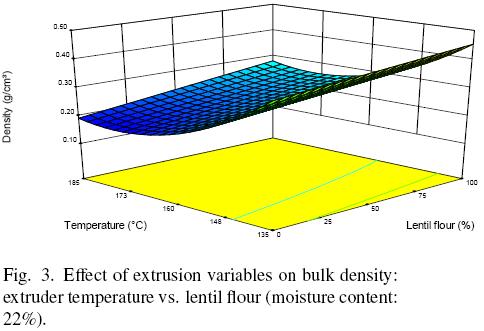
The highest value of BD was obtained at high levels of lentil flour in the blend processed at high moisture content. The increase of protein content on the extrudates can also influence density, since friction and shear during extrusion cause extensive interlacing between proteins and lead to their texturization and because high protein content promote denser and rigid extrudates products (Ruiz–Ruiz et al., 2008).
3.5 Maximum viscosity
RVA is used extensively to characterize the pasting properties of starch in grains and processed foods (Bryant et al., 2001; Kadan et al., 2003). In extruded products, the viscosity determined by RVA reflects the changes in pasting properties that result from starch structural changes during cooking and therefore gives an indirect evaluation of the extent of starch conversion. The model prediction for maximum viscosity (MV) is presented in Table 3, the determination coefficient for this model was R2 = 0.8348 and P = 0.0007, the terms T, C and the interaction of the terms MT and TC had a significant effect (P < 0.05) on MV.
The highest values of viscosity in the extrudates were associated with a high proportion of ungelatinized starch, whereas the lowest values of viscosity might reflect greater degradation and gelatinization of starch that is attributed to depolymerization and molecular entanglement resulting from the processing conditions (Hagenimana, et al., 2006). The response surface graph obtained for MV is shown in Fig. 4. The highest values of viscosity on the extrudates were determinated in the blends with highest level of banana flour, processes at low moisture content and low temperature. Under those conditions starch is not complete gelatinized, since gelatinization process is carry out in excess of water, while fusion of starch granules is produce at low water content but high temperature. The lowest values for MV were determined at low moisture content and high temperature. At high temperature the extruded mass became plastic and less viscous allowing the molecules to become more susceptible to compression during extrusion. Thus, greater thermal and mechanical action was produced, resulting in degradation of the starch granules and, consequently, lower viscosity value was obtained. Carvalho et al., (2002), has previously reported that high barrel temperatures and low feed moisture resulted in increased mechanical effort during the extrusion process of third–generation snacks, resulting in great starch degradation and low viscosity values. The lower viscosity values of the extruded materials compared with those of the untreated samples are probably a consequence of the denaturation of the protein, as well as the starch–protein interactions that produce structures with lower capacity for interaction with water and consequently low viscosity. The MV results for the extruded materials is attributed to the modification of the conformation of the proteins; many of the covalent bonds that stabilize the secondary structure are destroyed and new bonds can be form between the subunits (Lampart–Sczapa, et al., 2006) enabling the formation of starch–lipid and starch–protein complex, as well as retrograded amylose (Guha et al., 1998).
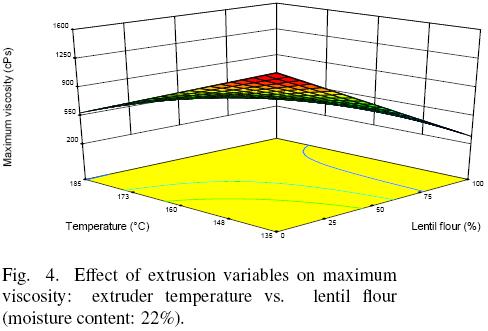
3.6 Final viscosity
The final viscosity (FV) is a measure of starch reassociation, which in extruded products, depends on modifications that occur in the structure of granules and molecules, and could give an indirect indication of how much RS can be formed via retrogradation of starch. The retrogradation has been reported to be of considerable practical importance since it affects textural changes in starchy foods. Amylose leaching, friction between swollen granules, granule swelling, and competition between leached amylose and remaining ungelatinized granules for free water have been reported to affect hot paste viscosity (Liu, et al., 1997).
The quadratic model fitted to the experimental results for FV that showed significant (P < 0.05) effect were the linear terms T and C, the quadratic terms M and T and the interactions MT and TC. Figure 5 illustrates the response surface graph obtained for the FV. An increase in FV was determinate for the extruded products with the highest proportion of banana flour in the blend and extruded at low temperature. This result could be associated with the increase of the starch content in the mixture and the extent reassociation tendency of the starch. However the FV decreased when the blend with high concentration of lentil flour and low moisture content was extruded at high temperature; this is probably due to the fact that during cooling the starch and the protein produce a weaker and less stable gel.
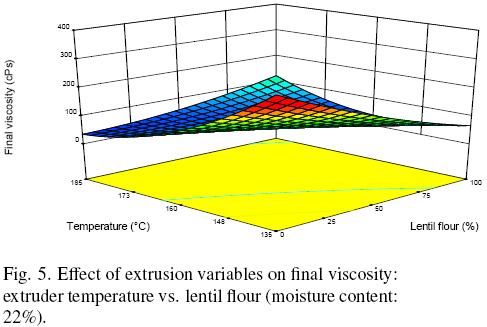
3.7 Total and resistant starch
Total starch value in the extruded products showed an increase from 34% to 65%, which was related to the level of the raw flours used in the blend. The regression equation for the relationship between resistant starch (RS) and the independent variables of lentil–banana flour concentration, moisture content and temperature obtained are presented in Table 3. The coefficient of determination (R2) was 0.8399 and it was significant (P < 0.05).
The linear effects of moisture and lentil flour concentration as well the quadratic effect of temperature and the interaction between moisture content and die temperature significantly influenced the resistant starch content in the products. Figure 6 illustrates the response surface graph obtained for the RS that ranged between 1.3% to 2.4%. The higher RS content was determined in the extrudates processed at 22–24% feed moisture, 160–175ºC and highest proportion of banana flour in the blend. Some authors reported that amylose content of 37% in banana starch (Yoshimoto et al., 2000; Tester, et al., 2004) and that extrudates with highest proportion of banana flour in the extruded blend showed the highest RS concentration.
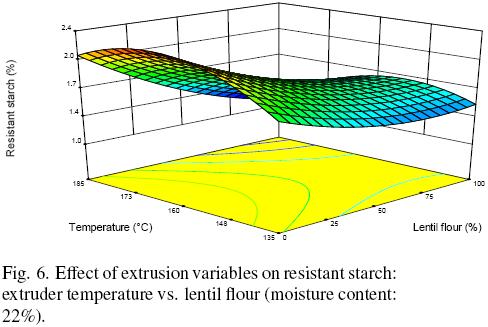
3.8 X–ray diffraction
X–ray diffraction was used to study the changes in the crystalline structure of the extruded products at the molecular level. The banana flour studied showed a relative crystallinity of 2.45% and C–type X–ray pattern with main reflections at 2θ values of 17°, 18° and 23° which agreed with González–Soto et al. (2007) report. The diffraction spectra of the lentil flour showed peaks at 29 values of 15°, 17.2° and 23.2°. This pattern closely matches the reported values for B–type legumes starches and the relative crystallinity of 1.30% determined in the flour 1.30% (Hoover and Ratnayake, 2002; Kaur et al., 2004).
During the extrusion process the organized crystalline structure of the raw materials are partially or totally destroyed, depending on the extrusion conditions principally due to the barrel temperature and feed moisture. These changes in the structure are also related with the starch source and other components present in the flour, such as proteins and fibers (McPherson, et al., 2000). Some degree of crystallinity in the extruded products was detected, partially organized in B–type crystalline structures. Those structures are very stable and known to be very resistant to a–amylase hydrolysis. These results showed the influence of the unripe banana flour, due to the main component of unripe banana which is starch as Guerra–Della et al. (2009) reported. These changes were also reflected in functional properties of the extrudate as BD and Viscosity and RS content .
Conclusions
Lentil and banana flours had several desirable attributes as functional ingredients to produce healthy new food products. The extrusion process induced additional modifications such as changes in WSI, BD, viscosity values and resistant starch content. The concentration of lentil/banana blends and temperature were the most important variables affecting the dependent variables (WSI, BD, MV and FV). All the dependent variables could be controlled by appropriated processing conditions. Mixtures with the highest concentration of banana flour and processed at 155° C produced products with highest resistant starch content.
Acknowledgements
The research was support by Instituto Politecnico Nacional, project SIP: 20100873. BPA, HHS, SME and MER received grant support EDI, COFAA and SNI. RHN received scholarship from CONACyT, México.
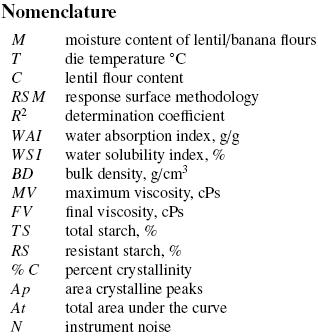
References
Adsule, R. N., Kadam, S. S. and Leung, H. K. (1989). Lentil. In Salunkhe, D. K. and Kadam, S.S. (Eds.) Handbook of world food legumes: Nutritional chemistry, processing technology, and utilization. Vol. 11 (p. 131). Boca Raton, FL: CRC Press. [ Links ]
Ali, Y., Hanna, M. A. and Chinnaswamy, R. (1996). Expansion characteristics of extruded corn grits. Lebensmittel–Wissenschaft und–Technologie 29,702–707. [ Links ]
Anderson, R. A., Conway, H. F., Pfeifer, V. F. and Griffin, E. L. (1969). Gelatinization of corn grits by roll and extrusion cooking. Cereal Science Today 14, 4–12. [ Links ]
Anderson, R.A. (1982). Water absorption and solubility and amylograph characteristics of roll–cooked small grain products. Cereal Chemistry 59, 265–269. [ Links ]
AOAC (1990). Official methods of analysis. Washington, DC: Association of Official Analytical Chemists. [ Links ]
Berrios, J. de J. (2006). Extrusion cooking of legumes: Dry bean flours. In Heldman, D. R. (Ed.). Encyclopedia of agricultural, food, and biological engineering (pp. 1–8). London, England: Taylor & Francis Group [ Links ]
Bryant, R.J., Kadan, R.S., Chamapagne, E.T., Vinyard, B.T. and Boykin, D. (2001). Functional and digestive characteristics of extruded rice flour. Cereal Chemisty 78, 131–7. [ Links ]
Cai, R., Klamczynska B. and Baik, B.K. (2001). Preparation of bean curds from protein fractions of six legumes. Journal Agricultural Food Chemistry 49, 3068–3073. [ Links ]
Carvalho, R. V., Ascheri, J. L. R. and Cal–Vidal, J. (2002). Efeito dos parametros de extrusao nas propriedades físicas de pellets (3G) de misturas de farinhas de trigo, arroz e banana. Ciencia e Agrotecnologia 26, 1006–1018. [ Links ]
Case, S. E., Hamann, D. D. and Schwartz, S. J. (1992). Effect of starch gelatinization on physical properties of extruded wheat– and corn based products. Cereal Chemistry 69, 401–404. [ Links ]
Colonna, P., Tayeb, J. and Mercier, C. (1989). Extrusion cooking of starch and starchy products. In C. Mercier, P. Linko, and J. M. Harper (Eds.). Extrusion cooking (pp. 247–320). American Association of Cereal Chemists, Inc. [ Links ]
Ding, Q.B., Ainsworth, P., Tucker, G. and Marson, H. (2005). The effect of extrusion conditions on the physicochemical properties and sensory characteristics of rice–based expanded snacks. Journal ofFood Engineering 66, 283–289. [ Links ]
Drago, S., Velasco–González, O., Torres, R., González, R. and Valencia, M. (2007). Effect of the extrusion on functional properties and mineral dialyzability from Phaseolus vulgaris bean flour. Plant Foods for Human Nutrition 62, 43–48. [ Links ]
Faisant, N., Gallant, D. J., Bouchet, B. and Champ, M. (1995). Banana starch breakdown in the human small intestine studied by electron microscopy. European Journal of Clinical Nutrition 49, 98–104. [ Links ]
Fernández–Gutiérrez, J.A., San Martín–Martínez, E, Martínez–Bustos, F. and Cruz–Orea, A. (2004). Physicochemical properties of casein–starch interaction obtained by extrusion process. Starch/Starke 56,190–198. [ Links ]
Fikry I. El–nahry., Foad E. Mourad., Sohair M. Abdel Khalik. and Nargis S. Bassily. (1980). Chemical composition and protein quality of lentils (Lens) consumed in Egypt. Plant Foods for Human Nutrition 30, 87–95. [ Links ]
Goñi, I., García, D. and Saura–Calixto, F. (1997). A starch hydrolysis procedure to estimate glycemic index. Nutrition Research 17, 427–437. [ Links ]
Goñi, I., García–Díaz, L., Mañas, E. and Saura–Calixto, F. (1996). Analysis of resistant starch: A method for foods and food products. Food Chemistry 56, 445–449. [ Links ]
Guerra–DellaValle, D., Sánchez–Rivera, M. M., Zamudio–Flores, P. B., Mendez–Montealvo G. and Bello–Pérez, L.A. (2009). Effect of chemical modification type on physicochemical and rheological characteristics of banana starch. Revista Mexicana de Ingeniería Química 8, 197–203. [ Links ]
González–Soto, R.A., Mora–Escobedo, R, Hernández–Sánchez, H., Sánchez–Rivera, M. and Bello–Pérez, L.A. (2007). The influence of time and storage temperature on resistant starch. Food Research International 40, 304–310. [ Links ]
Guha, M., Zakiuddin, S. andBhattacharya, S. (1998). Effect of barrel temperature and screw speed on rapid viscoanalyzer pasting behaviour or rice extrudates. International Journal ofFood Science and Technology 33, 259–266. [ Links ]
Hagenimana, A, Ding, X. and Fang, T. (2006). Evaluation of rice flour modified by extrusion cooking. Journal ofCereal Science 43, 38–46. [ Links ]
Hernández–Díaz, J.R., Quintero–Ramos, A., Barnard, J. and Balandran–Quintana, R.R. (2007). Functional properties of extrudates prepared with blends of wheat flour/pinto bean meal with added wheat bran. Food Science and Technology International 13, 301–308. [ Links ]
Hsieh, F., Peng, I.C. and Huff, H.E. (1990). Effects of salt, sugar and screw speed on processing and product variables of corn meal extruded with a twin–screw extruder. Journal ofFood Science 55, 224–227. [ Links ]
Hoover, R. and Ratnayake, W.S. (2002). Starch characteristics of black bean, chick pea, lentil navy bean and pinto bean cultivars grown in Canada. Food Chemistry 78, 489–498. [ Links ]
Juárez–García, E., Agama–Acevedo, E., Sayago–Ayerdi, S.G., Rodríguez–Ambriz, S.L. and Bello–Pérez, L.A. (2006). Composition, digestibility and application in breadmaking of banana flour. Plant Food for Human Nutrition 61, 131–137. [ Links ]
Kadan, R. S., Bryant, R.J. and Pepperman, A.B. (2003). Functional Properties of Extruded Rice Flours. Journal ofFood Science 68, 1669–1672. [ Links ]
Kaur, M., Singh, N., Singh–Sandhu, K., and Singh–Guraya, H. (2004). Physicochemical, morphological, thermal and rheological properties of starches separated from kernels of some Indian mango cultivars (Mangifera indica L.). Food Chemistry 85, 131–140. [ Links ]
Lampart–Szczapa, E., Konieczny, P., Nogala–Kalucka, M., Walczak, S., Kossowska, I. and Malinowska, M. (2006). Some functional properties of lupin proteins modified by lactic fermentation and extrusion. Food Chemistry 96, 290–296. [ Links ]
Lawton, B.T., Henderson, G.A. and Derlatka, E.J. (1972). The effects of extruder variables on the gelatinization of corn starch. Canadian Journal of Chemical Engineering 50, 168–172. [ Links ]
Leterme P. (2002). Recommendations by health organizations for pulse consumption. British Journal of Nutrition 88, S239–42. [ Links ]
Liu, H., Ramsden, L. and Corke, H. (1997). Physical properties and enzymatic digestibility of acetylated ae, wx, and normal corn starch. Carbohydrate Polymers 34, 283–289. [ Links ]
Liu, Y., Hsieh, E., Heymann, H. and Huff, H.E. (2000). Effect of process conditions on the physical and sensory properties of extruded oat–corn puff. Journal of Food Science 65, 1253–1259. [ Links ]
McPherson, A.E., Bailey, T.B. and Jane, J., (2000). Extrusion of cross–linked hydroxypropylated corn starches. I. Pasting properties. Cereal Chemistry 77, 320–325. [ Links ]
Mercier, C. and Feillet, P. (1975). Modification of carbohydrate components by extrusion–cooking of cereal products. Cereal Chemistry 52, 283–297. [ Links ]
Montgomery: Capitulo 11: Métodos de superficies de respuesta y otros enfoques para la optimización de procesos en: Diseño y análisis de experimentos, 2da ed. Editorial Limusa–Wiley, México, 2004, pp. 427–500. [ Links ]
Ramírez–Ortiz, M.E, San Martín–Martínez, E. and Martínez–Padilla, L.P. (2008). Rheological and thermal properties of extruded mixtures of rice starch and isolated soy protein. Starch/Starke 60, 577–587. [ Links ]
Rindlav–Westling, A., Standing, M. and Getenholm, P. (2002). Crystallinity and morphology of films of starch, amylose and amylopectin blends. Biomacromolecules 3, 84–91. [ Links ]
Rodríguez, G. M. E. Ph. D. Thesis, CINVESTAV–Mexico, 1995. [ Links ]
Ruiz–Ruiz, J., Martínez–Ayala, A., Drago, S., González, R., Betancur–Ancona, D. and Chel–Guerrero L. (2008). Extrusion of a hard–to–cook bean (Phaseolus vulgaris L.) and quality protein maize (Zea mays L.) flour blend. Food Science and Technology 41, 99–807. [ Links ]
Shams, H., Tahbaz F., Entezari, M. and Abadi, A. (2008). Effects of cooked lentils on glycemic control and blood lipids of patients with type 2 diabetes. Atherosclerosis Journal 3, 215–218. [ Links ]
Singh, B., Sekhon, K. S. and Singh, N. (2007). Effects of moisture and level of pea grits on extrusion behaviour and product characteristics of rice. Food Chemistry 100, 198–202 [ Links ]
Tester, R.F., Karkalas, J. and Qi, X. (2004). Starch composition, fine structure and architecture. Journal of Cereal Science 39, 151–165. [ Links ]
Velazquez–Trujillo, E., Bolaños–Reynoso, E. and Pliego–Bravo, Y.S. (2010). Optimization de la producción de carbón activado a partir de bambú. Revista Mexicana de Ingeniería Química 9, 359–366. [ Links ]
Wang, S.Y. and Ballington, J.R. (2007). Free radical scavenging capacity and antioxidant enzyme activity in deerberry (Vaccinium stamineus L.). Lebensmittel–Wissenschaft und–Technologie 40, 1352–1361. [ Links ]
Yoshimoto, Y., Tashiro, J., Takenouchi, T. and Takeda, Y. (2000). Molecular structure and some physicochemical properties of high–amylose barley starch. Cereal Chemistry 77, 279–285. [ Links ]














